The 11 Best Donor Management Software Choices in 2025

Effective donation management means more than tracking financial contributions. Finding the best donor management software is one of the best ways to engage your donors and enhance your fundraising approaches to generate interest, maximize impact, and build strong relationships with your donor base.
Selecting the best donor management software for their current needs, future goals, and constituent base size can make an immense difference in how public and small to medium nonprofit organizations acquire, engage, and retain donors to encourage more donations for a greater impact.
Keep reading to learn about the features, pricing, and best use cases of the top 11 donor management tools available.
1. Bonterra
Best for: Bonterra provides nonprofits of all sizes with innovative fundraising and engagement solutions to attract more donors and drive sustainable support.
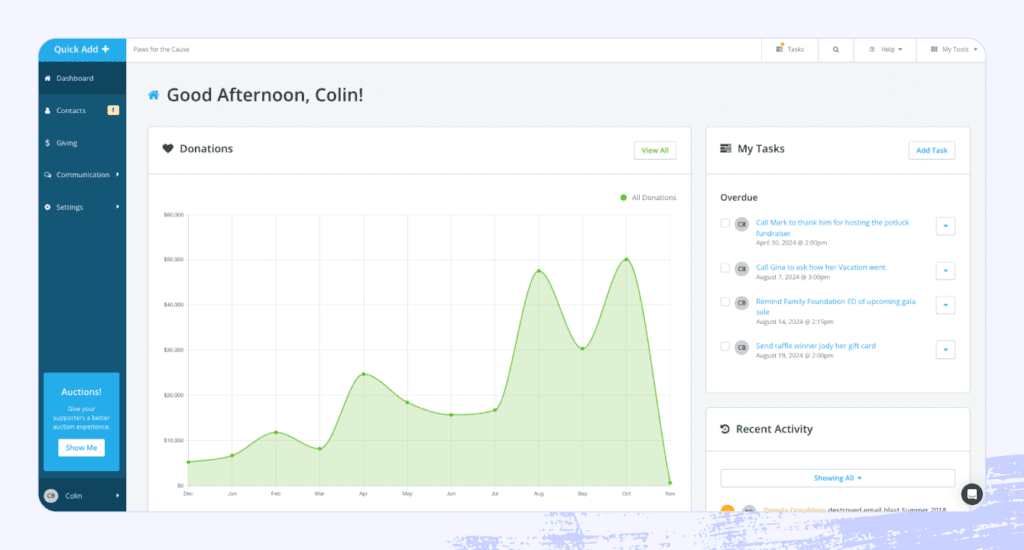
Bonterra Fundraising and Engagement allows you to customize and enrich donor experiences with easy-to-use software for every channel. With personalizable templates and prompts, you can use Bonterra to send emails or video messages, text donors, and create custom forms, all while keeping detailed donor information organized and accessible to inform your decisions.
Bonterra’s pricing model is tailored to your organization so you get the features and functionality you need most.
What are the payment options for Bonterra?
Bonterra accepts payments through Stripe and PayPal, so donors can contribute to your organization through a variety of payment options, including:
- ACH direct deposits
- Credit cards
- Apple Pay
- Google Pay
- CashApp
What are the Bonterra processing fees?
Processing fees typically depend on the payment platform used and the donation amount. For Bonterra, these may include:
- Stripe: 2.2% of the donation + 30 cents per transaction
- PayPal: 1.99% of the donation + 49 cents per transaction
Donors are primarily responsible for these fees, but you can opt into different coverages that allow your organization to pay for certain fees, such as those for matching donations.
2. Blackbaud
Best for: Mid- to large-size nonprofits with non-custom fundraising processes
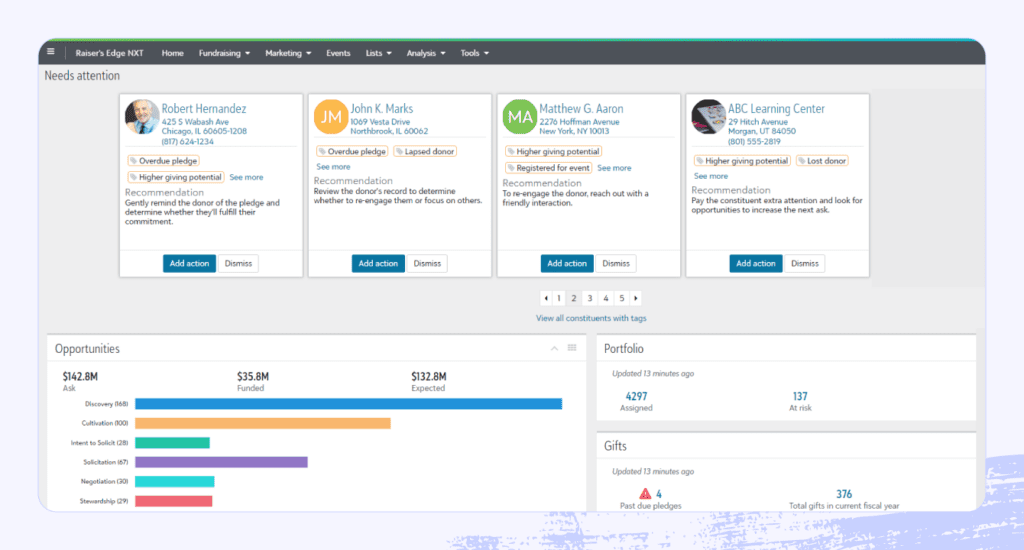
Blackbaud’s Raiser’s Edge NXT® is a simple CRM for fundraising featuring AI-enabled tools to inform donor engagement strategies. This software is fairly limited in capabilities and integrations, but it offers basic software for gaining donor insights and managing relationships.
What are the payment options for Blackbaud?
Donors have plenty of payment options they can use to make donations through Blackbaud, though some methods are only accepted through specific forms.
- Credit card
- ACH direct deposit
- Apple Pay
- Google Pay
- Venmo
- PayPal
What are the Blackbaud processing fees?
Organizations are responsible for all transaction and processing fees, which vary depending on the payment method and payment processor. You can opt into Blackbaud Complete Cover™ or donor cover models to limit the processing and transaction fees you have to pay.
The donor cover model allows donors to voluntarily cover processing fees so that you can receive the full amount of their donation. With the Complete Cover™ model, you’ll pay Blackbaud to cover up to $3,000 in processing fees for your donors, but you’ll be responsible for any transaction fees that exceed this limit.
How does Blackbaud compare to Bonterra?
Blackbaud and Bonterra offer similar donation management software solutions, but depending on the size and needs of your organization, Bonterra may be one of the best Blackbaud alternatives.
- Use cases: Blackbaud may be a better fit for larger organizations with standard fundraising processes, while Bonterra can best support small and growing nonprofits and public organizations.
- Features: Both software support donor segmentation, personalized messaging, and campaign management, but Bonterra easily generates more robust, informative reports on donor activity.
- Cost: You’ll need to request a quote for both Blackbaud and Bonterra software, as both are customized for each organization.
3. Bloomerang
Best for: Small nonprofits who are just getting started with a fundraising CRM
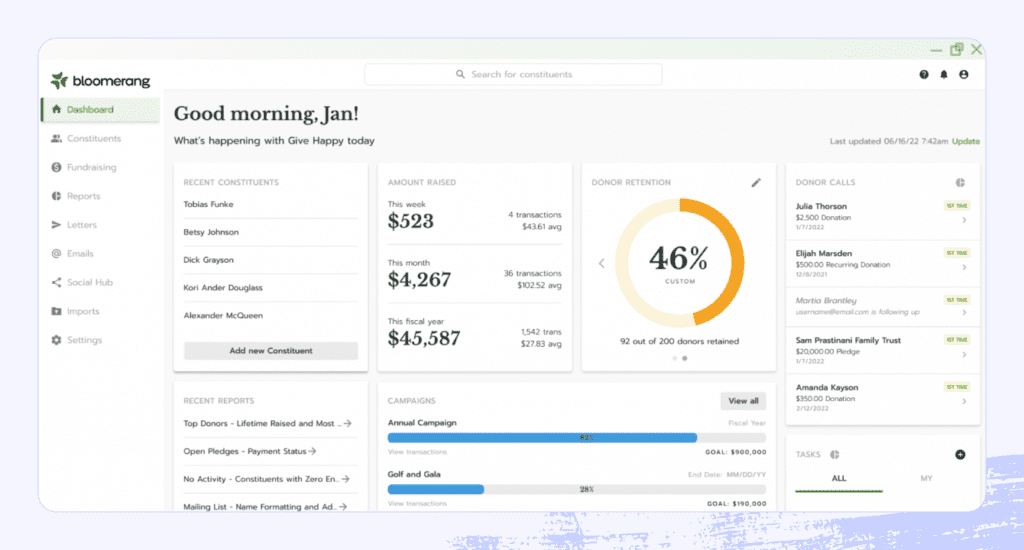
Bloomerang’s dedicated software offers a comprehensive CRM for donor and fundraising management with customizable forms and email templates to increase visibility on donor retention rates and activity.
What are the payment options for Bloomerang?
As an add-on to its donor management and fundraising software, Bloomerang offers its own payment processing solutions to streamline how your organization processes payments.
Using Bloomerang’s payment processing platform means you can accept several types of payments, including:
- Credit
- Debit
- PayPal
- Apple Pay
- Venmo
- ACH direct deposit
- In-person donations
What are the Bloomerang processing fees?
Depending on the payment processor you use, processing fees will vary. Even with Bloomerang Payment Processing, your donors can expect to pay an additional percentage of their donation per transaction, including:
- Visa, Mastercard, Discovery, and AMEX: 3.2% of the donation + 30 cents per transaction
- PayPal: 3.2% of the donation + 49 cents per transaction
- ACH eCheck: 1.8% of the donation + 30 cents per transaction
How does Bloomerang compare with Bonterra?
For small nonprofits, Bloomerang and Bonterra offer solutions to manage and evaluate donor relationships. Choosing between them requires familiarity with donor management solutions and organization goals.
- Use cases: Both Bloomerang and Bonterra are designed for smaller organizations, but Bonterra’s customized approach may be better suited to growing nonprofits.
- Features: Bloomerang and Bonterra feature an interactive dashboard with convenient integrations, but Bonterra software features automated workflows to simplify and streamline your processes.
- Cost: Bloomerang starts at $99 per month with optional add-ons for nonprofits with fewer than 1,000 constituents, while Bonterra’s pricing is tailored to your organization’s unique needs.
4. Little Green Light
Best for: Nonprofits and organizations looking for a comprehensive donor management platform
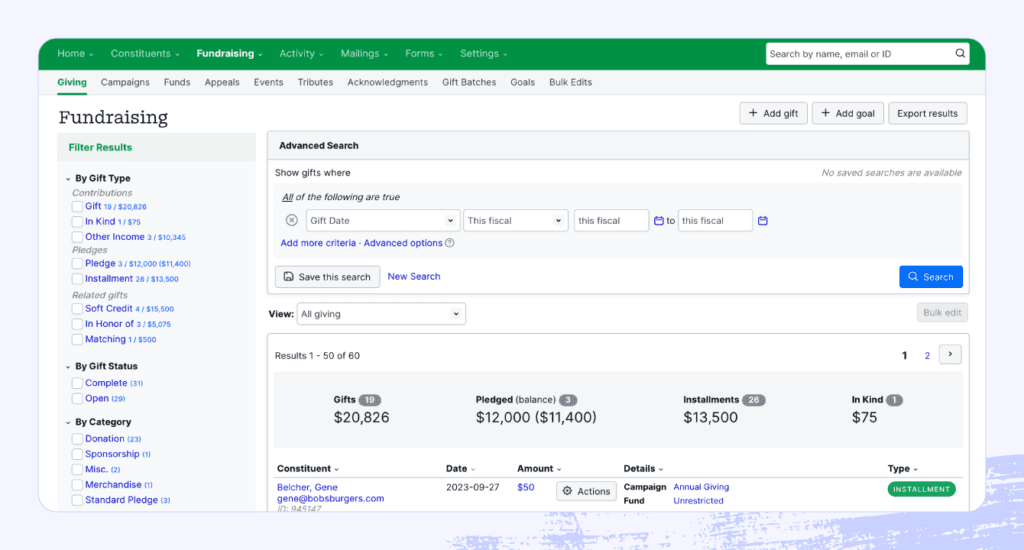
Little Green Light offers all-in-one donor management software that integrates with other tools like Zapier and QuickBooks. Their software can help consolidate tools used to manage, track, and acknowledge donations and donor relationships.
What are the payment options for Little Green Light?
Little Green Light partners with Stripe and PayPal to accept credit card payments, ACH direct deposits, and a wide variety of online payment options, including:
- USD bank transfers
- Affirm
- AfterPay
- Klarna
- Google Pay
- Apple Pay
- Cash App
What are the Little Green Light processing fees?
Processing fees for Little Green Light depend on the payment processor used.
- Stripe: 2.2% of the donation + 30 cents per transaction
- PayPal: 1.99% of the donation + 49 cents per transaction
Because the payment processor issues these fees, donors are responsible for paying them in addition to their donation amount.
How does Little Green Light compare with Bonterra?
Both Little Green Light and Bonterra provide donor management solutions to streamline fundraising efforts. If you’re looking for an easy-to-use, versatile solution with plenty of support, Bonterra’s fundraising and engagement software uses proprietary technology and automation to help your organization acquire more donors and encourage contributions.
- Use cases: Where Little Green Light may be a good fit for organizations looking to overhaul their processes, Bonterra is designed to accommodate your needs at any stage of development, especially as your organization grows.
- Features: Bonterra offers a suite of software to customize your donor management system with mobile functionality that Little Green Light’s all-in-one solution lacks.
- Cost: Little Green Light costs $486 to $2,268 per year, depending on the number of constituents in your organization.
5. Donorbox
Best for: Organizations aiming to increase their donations
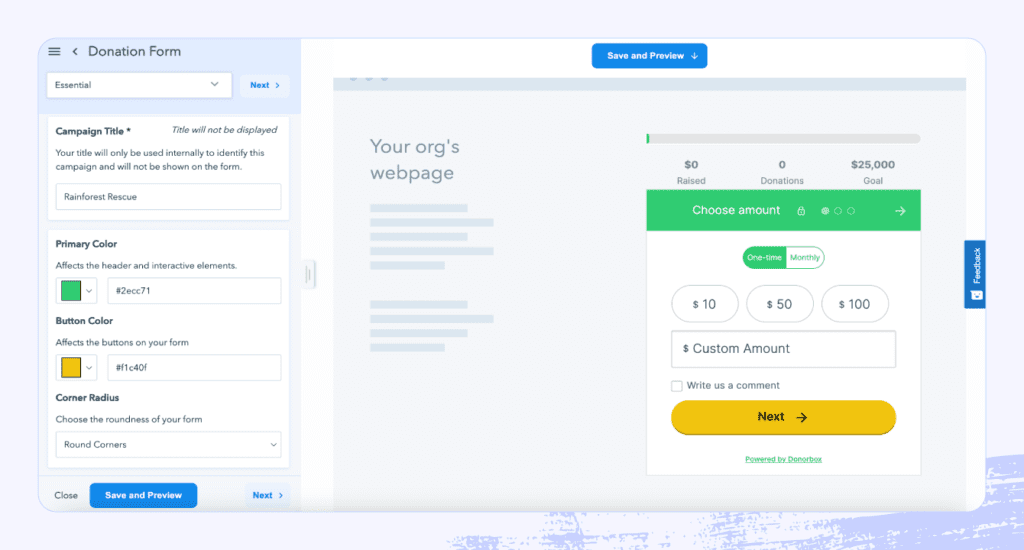
Donorbox is a dedicated fundraising platform that offers customizable donation forms, donor information management, and analytics to help nonprofits and other organizations fundraise more effectively.
What are the payment options for Donorbox?
Like other donor management platforms, Donorbox partners with Stripe and PayPal to accept a variety of payment types, including:
- Credit and debit
- ACH direct deposit
- Google Pay
- Apple Pay
- Venmo
What are the Donorbox processing fees?
Donorbox charges a platform fee each time a donor uses the software to make a donation. Organizations can give donors the option to cover these fees when donating.
- Standard plan: 1.75% per transaction
- Pro plan: 1.5% per transaction
- Custom plan: 1.5% per transaction
Donations made through PayPal or Stripe will also incur the platforms’ processing fees.
- PayPal: 1.99% of the donation + 49 cents per transaction
- Stripe: 2.2% of the donation + 30 cents per transaction
How does Donorbox compare with Bonterra?
Both Donorbox and Bonterra can help nonprofits and public organizations analyze and enhance fundraising strategies, but Bonterra may be a better option for growing organizations.
- Use cases: While Donorbox is versatile, it may be best for smaller organizations that want to improve their fundraising efforts rather than manage donor relationships.
- Features: Though Donorbox is a fairly limited platform, it can easily integrate with other donor management tools, while Bonterra offers an all-in-one donor management solution.
- Cost: Donorbox is one of the most affordable donation management options available, but the low cost comes with minimal customization compared to Bonterra.
6. Qgiv
Best for: Nonprofits with fewer than 10,000 constituents looking to optimize their fundraising efforts
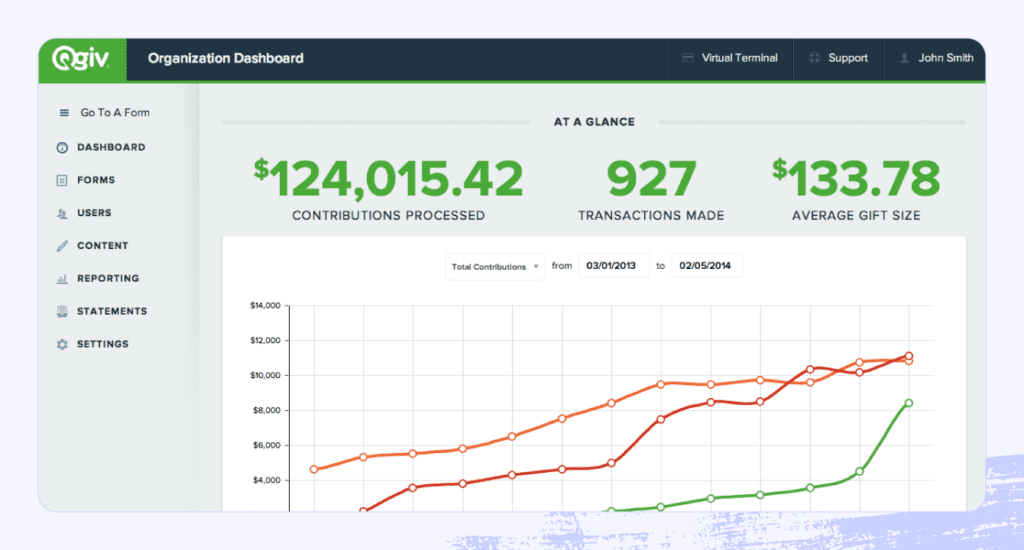
Qgiv, owned by Bloomerang, is a fundraising tool optimized for mobile giving with support for text-to-donate initiatives, peer-to-peer fundraising, and customizable donation forms. This software also offers event planning functionality and analyses of donors’ activity to inform future initiatives.
What are the payment options for Qgiv?
Qgiv natively accepts credit and debit card payments through text, donation forms, or on the Givi app. You can expand donors’ payment options by connecting other payment processors, including:
- Apple Pay
- PayPal
- Venmo
What are the Qgiv processing fees?
Depending on the payment type and the payment processor you use, Qgiv processing fees will vary. In most cases, your organization will need to pay these fees, but you can allow donors to cover processing costs.
- Qgiv (with Worldpay): 3.95% of donation + $0.30 per transaction
- eCheck: 1.95% of donation + $0.95 per transaction
- PayPal: 1.95% per transaction
- American Express: 1% of donation
How does Qgiv compare with Bonterra?
Qgiv and Bonterra have user-friendly interfaces that can help nonprofits expand and optimize donor management, but Bonterra’s robust reporting, analytics, and tracking capabilities make it more appealing to organizations aiming to grow.
- Use cases: Specific auction and peer-to-peer fundraising add-ons make Qgiv appeal to nonprofits with these goals, but Bonterra offers a custom approach to help growing nonprofits maximize their fundraising efforts.
- Features: Specialized for mobile fundraising, Qgiv is a great option for nonprofits who want a simple, easy-to-use fundraising management platform, but Bonterra offers donor segmentation and in-depth reports to enhance donor relationships.
- Cost: The baseline price for Qgiv is $25 per month or $60 per quarter, but add-ons for text-based fundraising, peer-to-peer fundraising, and auctions can exceed an additional $200 per month. Bonterra’s pricing is custom-made for each organization to best support their needs.
7. Kindful
Best for: Growing nonprofits looking for compatible software integrations for fundraising management
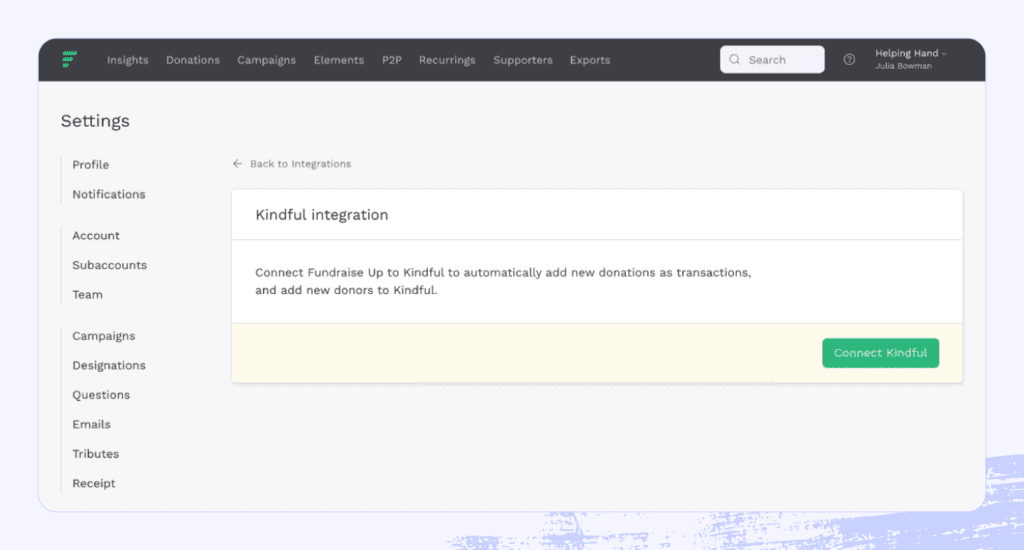
Kindful is a CRM for nonprofits with fundraising tools and donor analytics to help track and report on donations, fundraising initiatives, and more in one place. As a Bloomerang product, Kindful integrates with Bloomerang’s donor database for a comprehensive donor and fundraising solution.
What are the payment options for Kindful?
With Kindful, donors can use the following payment methods:
- Credit or debit
- Apple Pay
- Google Pay
- PayPal
- Venmo
What are the Kindful processing fees?
Processing fees for Kindful vary based on the payment method used. Organizations can expect to pay the following fees:
- PayPal: 3.2% of donation + 49 cents per transaction
- Visa, Mastercard, Discovery, and AMEX: 3.95% of donation + 30 cents per transaction
- ACH eCheck: 1.8% of donation + 30 cents per transaction
You can also give donors the option to cover these fees.
How does Kindful compare with Bonterra?
Though Kindful can easily integrate with other software, the product alone may not meet most nonprofits’ needs, compared to Bonterra, which provides an all-in-one donor management solution.
- Use cases: Bonterra’s reporting capabilities are more in-depth and complex than Kindful’s, though Kindful can integrate with additional software to cover this gap.
- Features: You can consolidate and organize donor data with Kindful, but Bonterra may provide a more thorough analysis with comprehensive reports.
- Cost: Kindful can cost between $119 and $699 per month while Bonterra’s pricing is customized to your organization’s unique needs.
8. DonorPerfect
Best for: Nonprofit organizations who want to increase fundraising results with a simple platform
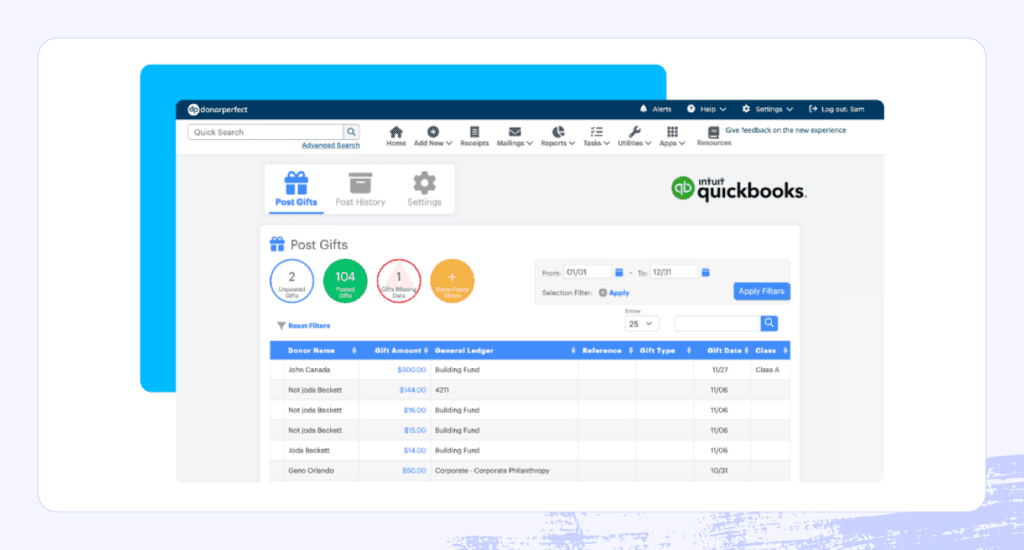
With interactive dashboards, customizable donation forms, and a donor profile builder, DonorPerfect is a complete platform for nonprofit organizations to manage donations, donor relationships, and more.
What are the payment options for DonorPerfect?
DonorPerfect accepts payments through PayPal, allowing donors to contribute to organizations with a variety of payment options, such as:
- Venmo
- Credit and debit cards
- eChecks
- ACH direct deposit
- Cryptocurrency
- PayLater
What are the DonorPerfect processing fees?
Processing fees for DonorPerfect vary by payment method and payment processor. Organizations can expect to pay the following fees:
- Visa, Mastercard, and Discover: 2.89% of donation + 30 cents per transaction
- AMEX: 3.39% of donation + 30 cents per transaction
- eCheck: 0.75% of donation + 35 cents per transaction
- PayPal: 2.89% of donation + 49 cents per transaction
How does DonorPerfect compare with Bonterra?
Both DonorPerfect and Bonterra offer software solutions that efficiently manage donor relationships and track fundraising efforts. If your organization is looking to optimize your initiatives, strengthen bonds with donors through donor stewardship, and gain more insight into donor activity, Bonterra may be a better fit.
- Use cases: Nonprofits looking for a thorough, comprehensive donor management software may look to Bonterra’s extensive list of features over DonorPerfect’s simplified approach.
- Features: Bonterra’s robust reporting capabilities are built-in, while DonorPerfect’s reports may be less detailed or more challenging to generate.
- Cost: Many of DonorPerfect’s features are costly add-ons, while Bonterra’s fully customized pricing reflects your organization’s needs.
9. Fundly
Best for: Individuals and organizations looking to raise funds online
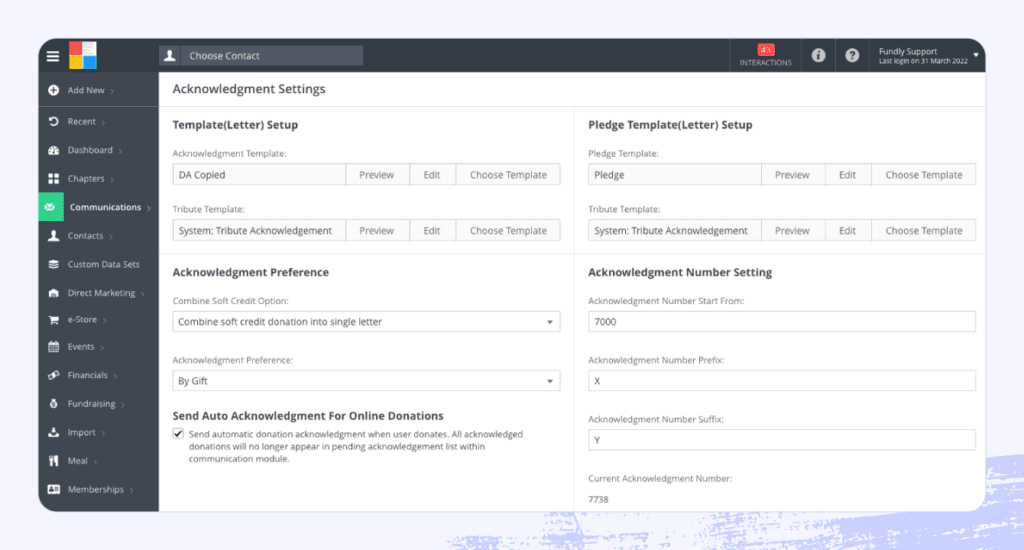
Fundly is a donation platform that allows individuals and organizations to create dedicated fundraising pages with integrations to encourage more giving and enhance the donor experience.
What are the payment options for Fundly?
Fundly partners with Stripe to accept multiple types of payment, such as:
- Credit
- Debit
- Apple Pay
- Google Pay
- Afterpay
- Cash App
What are the Fundly processing fees?
It won’t cost organizations anything to make a donation page with Fundly, but they can expect to pay these fees:
- Stripe: 2.9% of donation + 30 cents per transaction
How does Fundly compare with Bonterra?
While Fundly and Bonterra offer software to improve fundraising efforts, Fundly is more limited in analytics, reporting, and donor management.
- Use cases: Fundly is an ideal platform for individuals or small organizations simply looking for an efficient way to fundraise online, whereas Bonterra offers a complete software solution for donation management.
- Features: Bonterra allows you to customize donation pages, organize and analyze donor data, and manage donor engagement, while Fundly primarily offers customizable fundraising pages with data insights.
- Cost: Fundly is free to use with limited capabilities, while Bonterra’s pricing is tailored to your organization’s needs.
10. DonorSnap
Best for: Nonprofits who want an affordable donor management CRM
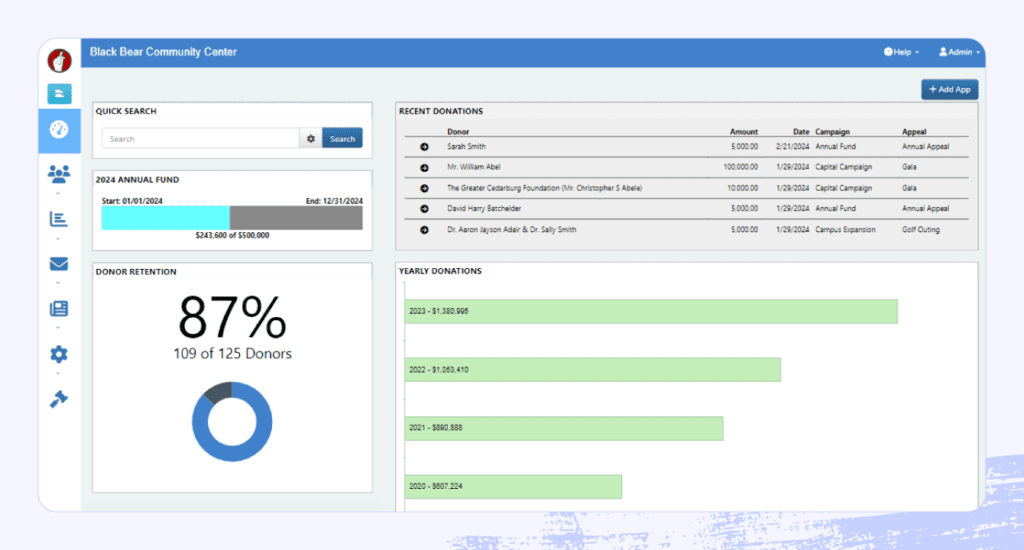
DonorSnap provides features like donor persona tracking, standard reporting, and integrations with email providers and QuickBooks to streamline donor management at a low cost. The software’s interface isn’t as easy to use as other options, but for those familiar with comparable CRM functionality, this budget-friendly option may be worth considering.
What are the payment options for DonorSnap?
DonorSnap’s built-in Responsive Forms tool accepts credit and debit card payments, but it can integrate with other payment processors.
DonorSnap’s preferred payment processor is Stripe, which allows donors to use a variety of payment types, such as:
- ACH
- PayPal
- Venmo
- Apple Pay
- Google Pay
What are the DonorSnap processing fees?
Credit card companies and payment processors charge additional processing fees, which may vary depending on the company, processor, and payment type. Using Stripe with DonorSnap will incur the following fees:
- Visa, Mastercard, and Discover: 2.2% of donation + 30 cents per transaction
- AMEX: 3.5% of donation + 30 cents per transaction
- ACH transactions: 0.8% of donation capped at $5
How does DonorSnap compare with Bonterra?
DonorSnap is far from the easiest donor management software to use, but its no-nonsense approach may appeal to organizations that have previously used other CRMs. For a more user-friendly, comprehensive approach to donor management, Bonterra appeals to small and mid-sized organizations that want to grow their fundraising efforts.
- Use cases: Experienced organizations who want data without frills may opt for DonorSnap, but Bonterra provides an easy-to-use interface with in-depth reports to inform your strategies.
- Features: Both DonorSnap and Bonterra allow you to customize donation pages, monitor donor activity, and generate reports to analyze donation trends, but you may have an easier time creating and interpreting reports from Bonterra’s software.
- Cost: Depending on the number of constituents in your organization, DonorSnap can cost between $50 and $250 per month, while Bonterra’s quotes are always customized to each organization’s needs.
11. Keela
Best for: Fundraisers who want to increase donations and build donor relationships through stewardship
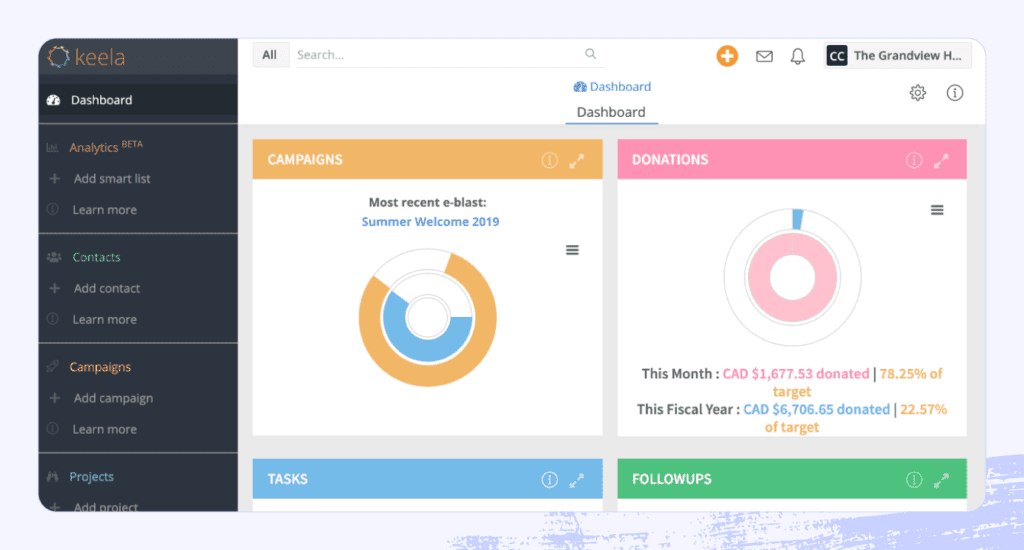
With a clean, streamlined look, Keela provides AI-enhanced fundraising software designed to boost donations and improve donor relationships.
What are the payment options for Keela
In addition to their own payment processor, KeelaPay, Keela partners with Stripe and PayPal so donors can make contributions using the payment methods of their choice, including:
- Digital wallets (Apple Pay, Google Pay, Venmo)
- Credit and debit cards
- eChecks
- Klarna
What are the Keela processing fees?
Processing fees for Keela depend on the type of organization you have, the payment processor, and the payment method used. For nonprofits, fees may include:
- Stripe and PayPal: 2.2% of donation + 30 cents per transaction
- Visa, Mastercard, and Discover: 2.2% of donation + 30 cents per transaction
- AMEX: 3.2% of donation + 30 cents per transaction
- eCheck: 75 cents per transaction
How does Keela compare with Bonterra?
For a streamlined approach to donor management, Keela’s simplified CRM with AI can help your organization prioritize your most productive initiatives. Built for in-depth reporting and comprehensive analysis, Bonterra offers a way to organize donor data to improve donor experiences, build stronger relationships, and identify ideal opportunities to reach out.
- Use cases: Adopting Keela or Bonterra can help you retain donors with their streamlined looks, while Bonterra can also provide you with more insights to inform your fundraising strategies.
- Features: AI-enhanced features help improve tedious processes through Keela, while Bonterra allows complete customization to tailor your messaging and connect with donors.
- Cost: Keela costs between $99 and $350 per month depending on the number of contacts imported and whether you pay monthly or annually. You’ll get a custom quote from Bonterra to suit your organization’s unique needs.
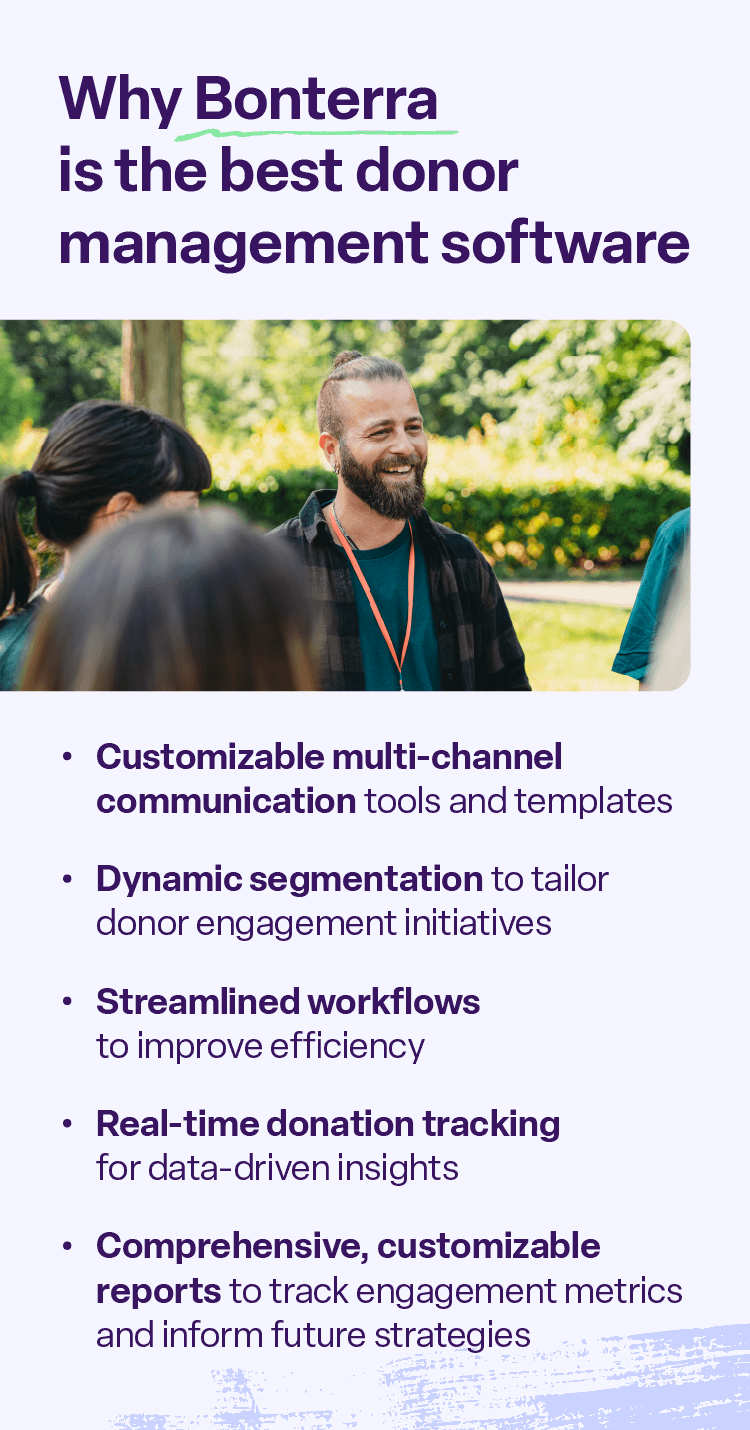
How to compare donor management software options
The best online donor management software varies based on your organization’s unique needs. Finding the right option depends largely on the size of your organization as well as your fundraising goals.
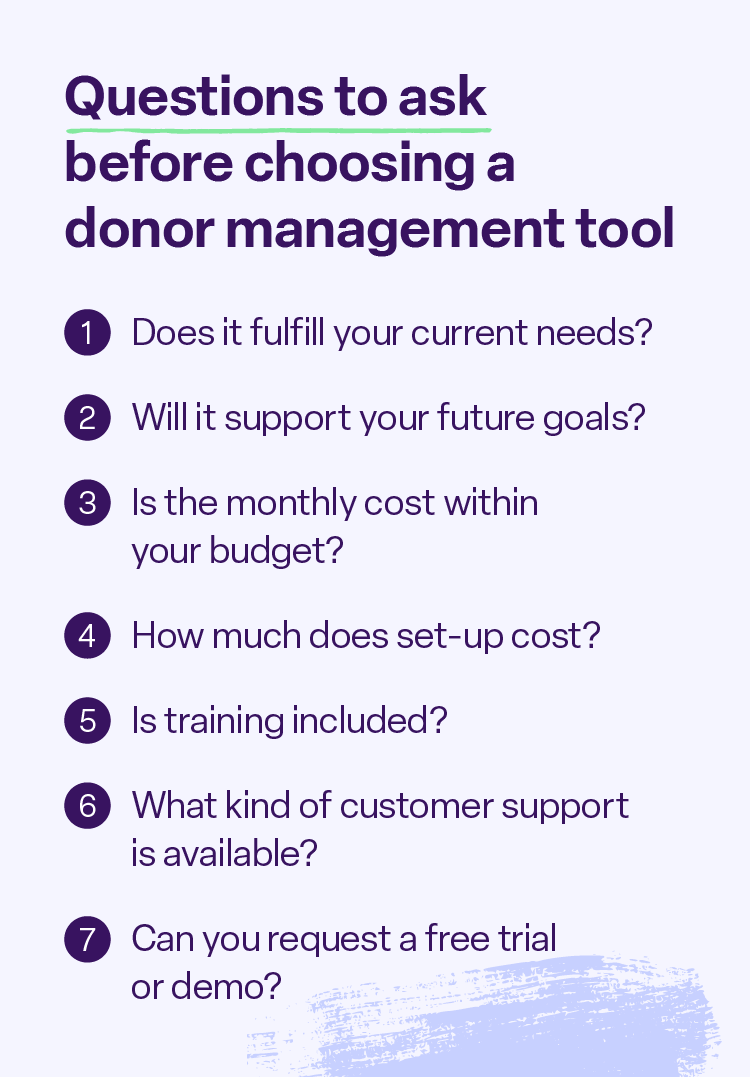
Before you commit to a donor management software solution, compare your options based on the following:
1. Prioritize features that fit your goals
From comprehensive CRMs to donation page builders, the available donor management options range in capabilities, so it’s important to determine what features you need to accomplish your goals. Some features to look for may include:
- Donor management: Software that allows you to create donor profiles, segment donor groups, track donations, and gauge donor readiness is key to effective donor management.
- Fundraising tools: A platform that allows you to customize donation pages or forms is a good place to start, but you can also look for text-to-give and peer-to-peer fundraising functionality.
- Donor messaging: Keeping in touch with donors is essential to building donor relationships. Look for a donor management tool that generates email receipts and offers email marketing options.
- Tracking and analytics: For growing organizations, data tracking and reporting is critical. Software with an easy-to-use donor dashboard and automated reporting can help inform your strategies.
- Integrations: If you use other software to track donor information or manage finances, consider a donor management platform that can conveniently integrate with what you already have.
Knowing why donors give can inform what features you should prioritize. Personalized engagement, trust in your organization, and clarity about the impact of their donations can encourage donations and strengthen your donor relationships.
2. Evaluate scalability and support
Even if you’ve worked with a nonprofit CRM before, learning a new platform can be challenging. Look into what training options are available as well as the level of support you’ll be able to access for each software you’re considering.
As your organization grows, you’ll want to avoid switching software to minimize disruptions and maximize the effectiveness of your fundraising. Verify that the software you want to use can scale with your organization to accommodate more constituents and the level of messaging, engagement, and reporting you’ll need.
3. Demo the platform before committing
Get a feel for how the software works and the features it offers by requesting a demo. Many donor management tools offer similar features, but you want to choose one that feels intuitive and aligns with your existing processes.
Which is the best donor management software for nonprofits?
While each fundraising management software described above offers accessible technology to simplify donation management and improve your relationship with donors, Bonterra leads the pack.
As the best fundraising software for small-to-mid-sized public organizations and nonprofits, Bonterra provides an all-in-one donor management solution with the following features:
- Donor tracking: With multi-channel communication tools, Bonterra streamlines donor tracking and engagement to strengthen relationships and improve retention.
- Comprehensive reporting: Growing organizations can make better data-driven decisions with user-friendly dashboards to track donor activity and engagement levels.
- Campaign management: Bonterra offers convenient templates, drag-and-drop tools, and A/B testing to customize and refine your campaigns, allowing nonprofits to maximize their impact.
- Scalable design: Bonterra’s flexible software is designed to help improve efficiency and donor relationships as your organization grows, allowing you to focus on doing more good.
FAQ
What’s the most affordable donor management software?
The most affordable donor management system may not be the best fit for your organization, but if you’re searching for an inexpensive option, Fundly has the lowest upfront cost and processing fees. The biggest downside of Fundly is its limited capabilities, as it is primarily used to create individual donation pages rather than manage and analyze donor engagement initiatives.
Rather than choosing fundraising software based on total cost, carefully evaluate your options to determine which has the features you need at scale. Depending on your organization’s size, projected growth, and objectives, you may find one software is a better value than another.
What is the difference between a CRM and a donor management system?
Customer or constituent relationship management (CRM) software is a tool nonprofits and other organizations use to broadly manage customer or donor relationships in addition to other aspects of the organization, such as volunteer coordination, event planning, and email marketing.
A donor management system is dedicated to managing donor relationships from start to finish to provide data, insights, and reports on donor engagement and activity to better inform fundraising efforts. Many CRMs encompass donor management features to streamline organization and improve efficiency.
Build stronger donor relationships with Bonterra
As the best donor management software for small nonprofits and growing public organizations, Bonterra is designed to streamline your organization’s fundraising efforts, personalize donor messaging, and generate comprehensive reports to drive future success with data-driven insights.
If you’re looking for an all-in-one donor management solution, Bonterra’s user-friendly dashboard enables you to develop meaningful donor relationships, optimize your workflows, and maximize your impact in an easy-to-learn platform. Get a feel for our fundraising and donor engagement software with a free demo, and if you have any questions, contact our support team by phone, email, or chat.
Work with Bonterra



